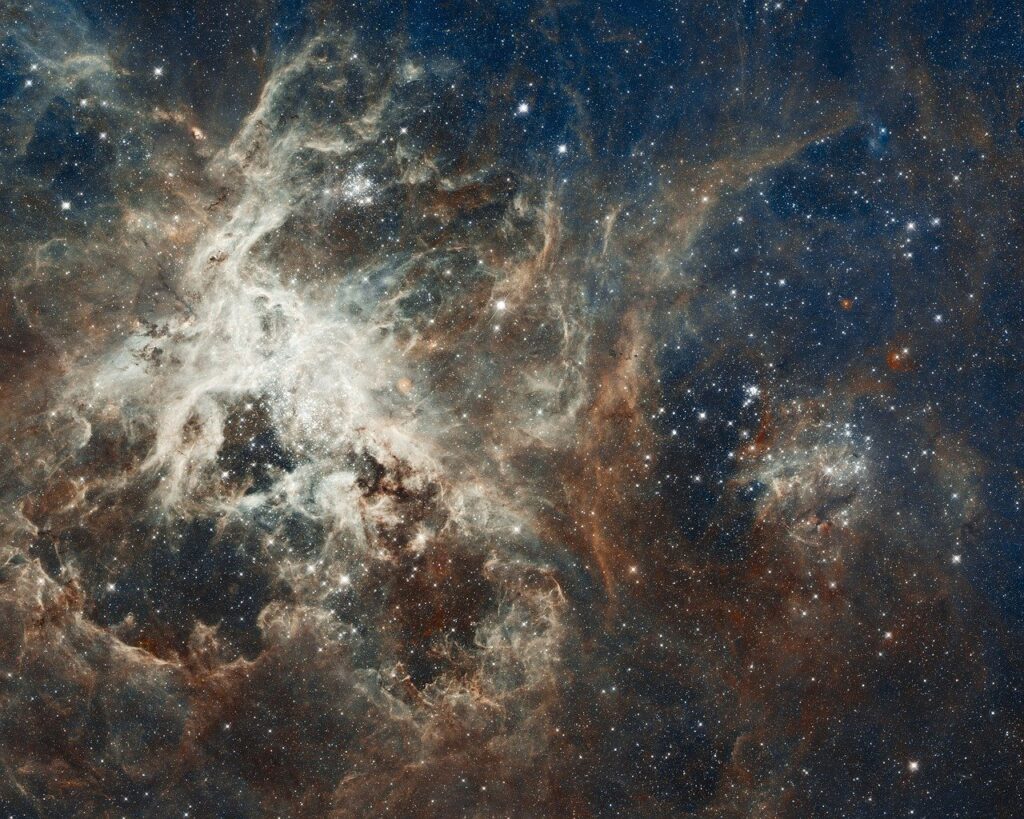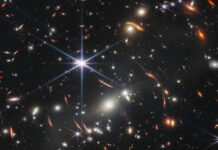Arecibo collapses
Around December 1, 2020, as a result of an earthquake with an epicentre in the Dominican Republic, Puerto Rico’s Arecibo Observatory radio telescope’s director (the structure suspended above the telescope dish) crashed down onto the concrete dish below.
It seems the cables supporting the director were on their last legs anyway, and the seismic waves from the neighbouring Dominican Republic were just enough to cause the old and weakened cables to give way and break.
Will we ever see Arecibo rebuilt?
Jupiter-Saturn conjunction
December 21, 2020, marked the 2020’s Winter Solstice. It also marked the Jupiter-Saturn conjunction event’s climax, where, seen from Earth, these two Jovians appeared almost on top of each other in the dusk sky. While the minimal separation of the conjunction was reached on the 21st of December, it is still possible to see the two planets quite close together for the next month.
The Jupiter-Saturn conjunction event occurs roughly every twenty Earth-years.
The next “WOW” signal?!
Not saying it’s aliens, but… it’s probably not aliens. In mid-December, the SETI (the Search for ExtraTerrestrial Intelligence) detected a brief radio signal, since named “BLC-1” (Breakthrough Listen Candidate #1), whose intensity was on par with the so-called “WOW signal”.
As if that weren’t interesting enough, the new signal’s source is Proxima Centauri! This red dwarf, possibly a member of the Alpha Centauri system (astronomers are not yet sure if Proxima is gravitationally related to Alpha Centauri or not) is known to harbour Proxima b, an Earth-sized exoplanet within Proxima’s habitable zone.
The signal’s nature is similar to the kind of stuff we humans usually transmit, and it’s since been deemed likely, though not yet confirmed or denied, that the signal itself was created here on Earth by humans – for example, from other researchers using a nearby microwave or an overhead satellite temporarily passing between Proxima and Earth.
The articles on the matter have yet to be published, and I can sense many people eagerly awaiting those results! Including myself.
Betelgeuse gets smaller…, plus the newest largest star
2020 was also the year many astronomers thought the red supergiant star Betelgeuse would go supernova before our eyes. It didn’t –we haven’t seen the light from the event yet – but instead we did come to find that this monster of a star is smaller in size, and even closer to Earth than we first realised.
Betelgeuse holds the title of the nearest supergiant star to the Earth, at – now – 530 light-years (ly) from Earth (previously, Betelgeuse was determined to be 25% further away, at 660 ly). Its diameter was refined to a similar extent, decreasing from Jupiter’s orbit-size to a third smaller; in other words, now 750 times the Sun’s diameter.
Betelgeuse is still one of the largest stars we know of, but now we know it to be a bit smaller and closer.
Speaking of big stars, we very recently crowned the newest largest star by diameter that we know of. The “Stephenson 2-18” (St2-18) is located in a cluster in Scutum named Stephenson 2. The constellation Scutum is also home to the last title-holder: UY Scuti.
St2-18 and UY are both “evolved” red supergiant stars, meaning they’re on their last legs before supernova, just like Betelgeuse. St2-18 has a diameter 2,150 times that of our Sun, meaning this star if placed instead of our Sun in the Solar System would sit with its surface at Saturn’s orbit.
While St2-18 is the biggest known star, the title of “heaviest” belongs to the so-called “Pistol Star” which is a blue hypergiant found in the Central Cluster of stars about the core of the Milky Way galaxy. Its mass is 100 times that of our Sun or more.
The most accurate clock thus far ever made
To wrap up 2020, scientists examined the most accurate atomic clock ever built and published their conclusions. It is an atomic clock that, unlike predecessors, adds quantum entanglement to the mix.
Atomic clocks keep time by counting the number of oscillations that its target atoms oscillate at. Cesium-133 (Cs-133) is the standard of reliable atomic clocks and is also used in this new entangled-atomic clock.
Usually, Cs-133 oscillations are not regular: they cause minor perturbations, small emissions of energy waves, that slightly alter that regularity.
However, as reported in an article by Edwin Pedrozo-Peñafiel’s team this past year, entangling the Caesium atoms was sufficient to greatly reduce, but not eliminate, the effects of those perturbations.
This new record-accurate clock now blows previous atomic clocks out of the water; it will require over a trillion years, over a hundred times the current age of our Universe, for this clock to become inaccurate by a mere second.
Happy New Year!
References and further reading:
>The Jupiter-Saturn conjunction = https://www.nasa.gov/feature/the-great-conjunction-of-jupiter-and-saturn, https://earthsky.org/astronomy-essentials/great-jupiter-saturn-conjunction-dec-21-2020.
>Atomic clock paper = https://arxiv.org/abs/2006.07501
>Anton Petrov on the new atomic clock, and a history of time-keeping = https://www.youtube.com/watch?v=ogDBFD7tr90





